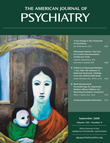Dr. Emslie Replies
To the Editor: We appreciate the comments submitted by Drs. Deshauer and Grimshaw and agree that the study design they propose would answer thought-provoking questions regarding the long-term risks and benefits of antidepressants and placebo. However, it would not address the question we attempted to answer in our study. A randomized discontinuation design intends to assess whether—in this case—12 weeks of treatment with an antidepressant are adequate to prevent relapse. We have already demonstrated that fluoxetine is more effective than placebo acutely in three separate studies (1 – 3) . These previous studies, along with multiple other factors, will be used to inform clinicians about whether to initiate treatment with an antidepressant. This study, on the other hand, was intended to inform clinicians about how long to continue antidepressant treatment once it has been initiated.
To assume that discontinuation trials apply only to patients who respond to drug therapy, as suggested by Drs. Deshauer and Grimshaw, is clearly incorrect. The placebo response rates in the acute fluoxetine trials ranged from 33%–37%. Therefore, it can be argued that a similar percentage of the youths who were treated openly during the acute phase of our study were, in fact, patients who responded to placebo. Unfortunately, there currently is no definitive method to identify these patients. While the classic two-arm parallel group design may have been conducted in studies of adults with depression, the majority of adult trials that have attempted to answer the question of relapse prevention utilized the Food and Drug Administration recommended discontinuation design, such as the one used in our study.
1. Emslie GJ, Rush AJ, Weinberg WA, Kowatch RA, Hughes CW, Carmody T, Rintelmann J: A double-blind, randomized, placebo-controlled trial of fluoxetine in children and adolescents with depression. Arch Gen Psychiatry 1997; 54:1031–1037Google Scholar
2. Emslie GJ, Heiligenstein JH, Wagner KD, Hoog SL, Ernest DE, Brown E, Neilsson M, Jacobson JG: Fluoxetine for acute treatment of depression in children and adolescents: a placebo-controlled, randomized clinical trial. J Am Acad Child Adolesc Psychiatry 2002; 41:1205–1215Google Scholar
3. March J, Silva S, Petrycki S, Curry J, Wells K, Fairbank J, Burns B, Domino M, McNulty S, Vitiello B, Severe J; Treatment for Adolescents With Depression Study (TADS) Team: Fluoxetine, cognitive-behavioral therapy, and their combination for adolescents with depression: Treatment for Adolescents With Depression Study (TADS) randomized controlled trial. JAMA 2004; 292:807–820Google Scholar



